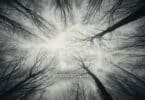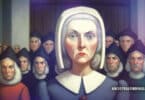Nineteen people were executed by hanging during the 1692 Salem witch trials, with a 20th being pressed to death to try to force a confession from him (to his credit, he never plead one way or the other, knowing the city could take his property from his heirs if he said anything). The tradition has long been that the victims of the witch trials were hanged on the summit of Gallows Hill, and their bodies were buried together in a shallow pit at the site, since, as convicted witches, they would not be allowed burial in consecrated ground in the city cemetery.
Yet, the story of the place of the hangings and what happened to the bodies is only that… tradition. While there is usually a truth behind historical and genealogical traditions, the real story can often get lost in the retelling. This is what happened with the Salem witch trial executions. Fortunately, new research has revealed the actual location of the hangings and the likely fate of the bodies of those who were hanged there. This is important to genealogists with Salem roots in several ways.
The Traditional Location is Close to the Actual Location
Like most genealogical and historical traditions and myths, there is a grain of truth in the story of the executions taking place on Gallows Hill. The truth of the matter is that they took place not at the summit of the hill, as tradition says, but near the bottom of it, on a rocky outcropping called Proctor’s Ledge. Today, it is located in a residential neighborhood, with some commercial buildings behind it. Residents of the neighborhood who have lived there a while have always suspected Proctor’s Ledge may have been the actual location of the hangings.
Interestingly, Proctor’s Ledge is named after Thorndike Proctor, a son of witch trial victim John Proctor, who bought the land after the witch trial delusions were over. As far as historians can tell, no executions but the ones from the witch trials ever took place there, before or after 1692.
Using a precious few snippets of eyewitness testimonies to the executions located in the thousands of pages of original documents produced by the witch trials, along with comparing old maps and new maps, as well as using satellite images and ground-penetrating sonar, Proctor’s Ledge was definitively confirmed as the site. There are only a couple of statements in the witch trial documents from people who actually witnessed the hangings, but they proved invaluable in locating the place. What these people said they saw, and where they were when they said they saw it enabled historians and archaeologists to use maps both old and new, including satellite imagery, to pinpoint the place. From the vantage point of the eyewitnesses, the summit of Gallows Hill would not have been visible. Further, the summit is too high to have easily pulled a wagon full of prisoners up to it. Finally, the town and church leaders would have wanted as many people as possible to see the executions. This makes the low, rocky outcropping of Proctor’s Ledge the only possible location when the eyewitness accounts are taken into consideration.
No Gallows, No Bodies
There is no room to build gallows on Proctor’s Ledge. This fact, along with the lack of reports of any gallows being built for the witch trial executions, and no debris being found at the site led researchers to conclude the convicted witches were hanged from trees. Also, the ground penetrating sonar revealed no bodies at the site. This also makes sense, as the soil on the ledge is too thin to make a shallow grave for even one person, much less a pit for nineteen convicted witches.
So, where are the bodies? Tradition has long said that the sons of convicted and executed witch Rebecca Nurse came back to the execution site under cover of darkness and removed their mother’s body for burial in the family cemetery. There is certainly a headstone for her in the family cemetery today, though it was erected long after the execution. George Jacobs, another witch trial victim, was also said to have been removed from the execution site by his family and buried on their farm. This was confirmed in 1864 when his heirs discovered his body on the property. In 1992, it was sent to Danvers, MA to be buried in the Nurse family cemetery in commemoration of the 300th anniversary of the witch trials.
Because no bodies were found on the site of the hangings, this likely means that ALL of the victims were moved by their families and buried privately on the family property.
Significance for Genealogists
Knowing where the site of the hangings took place means descendants of those involved in the trials can visit it and honor their ancestors there. The city of Salem is already planning some kind of memorial for the place, which will likely be small in keeping with the character of the residential neighborhood where it is. Those with ancestors who were hanged can stand in the spot that was the last place those ancestors saw while on earth. Knowing the families probably buried all the victims on the family property will give those with “witch” ancestry a better idea of where their ancestor now rests.
Looking at old maps to discover where family farms were once located and where that property is today will give descendants at least a general idea of the resting places of their witch trial victim ancestors. With the discovery of Proctor’s Ledge and what likely happened on it, genealogists with a connection to the witch trials have a more complete picture of what really happened to their ancestors than they did in the past, and this is always one of the most important parts of genealogy.





